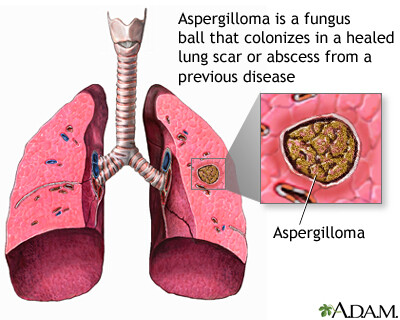An aspergilloma of the lung may develop in individuals who have preexisting cavitary lung disease caused by conditions such as tuberculosis, sarcoidosis, silicosis, or bronchiectasis. Also known as a fungus ball or mycetoma, aspergillomas can be regarded as heavy Aspergillus colonization of the preexisting cavity.
Clinical Findings
Signs and Symptoms
The most common symptom is hemoptysis, and, on rare occasions, severe or fatal hemoptysis can develop. Other symptoms are usually related to the underlying lung disease.
Laboratory Findings
Patients with an aspergilloma of the lung typically have elevated IgG levels specific for Aspergillus spp. Sputum smear may show the presence of filamentous fungi, and culture is intermittently positive for Aspergillus spp.
Imaging
The chest x-ray will show typical findings of a fungus ball with an air crescent sign. Both CT and magnetic resonance imaging (MRI) of the chest reveal the fungus ball.
Differential Diagnosis
In a patient with a history of prior lung disease, hemoptysis should lead to the suspicion of a fungus ball. Other fungi including Pseudallescheria boydii can cause a similar syndrome. Other causes of hemoptysis including tuberculosis, pulmonary embolism, lung cancer, and bronchiectasis need to be considered.
Complications
Death due to overwhelming hemoptysis is a rare complication of aspergilloma.
Diagnosis
The diagnosis is established by demonstrating the typical findings on imaging studies and the presence of Aspergillus organisms from sputum culture. The other common causes of hemoptysis need to be excluded with the appropriate investigations.
Treatment
Treatment for aspergilloma must be individualized (see Box 2). For patients with mild hemoptysis, observation alone is warranted. Patients with more significant hemoptysis may benefit from lobectomy, but preexisting lung disease may place the patient at increased risk for surgical complications. There is no role for systemic antifungal therapy. No consistent benefit has been derived from intracavitary installation of amphotericin B.
Prognosis
Most patients with mild stable hemoptysis do very well. In some patients, the fungus ball may gradually enlarge, and close observation of these patients is warranted.
Links
https://en.wikipedia.org/wiki/Aspergilloma
https://www.sciencedirect.com/topics/medicine-and-dentistry/aspergilloma



